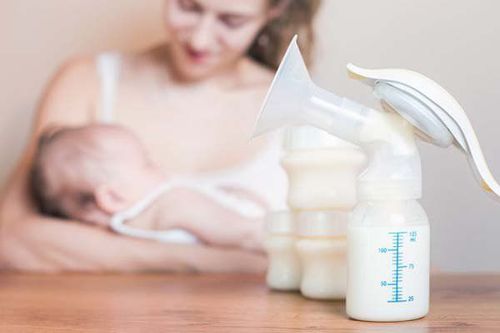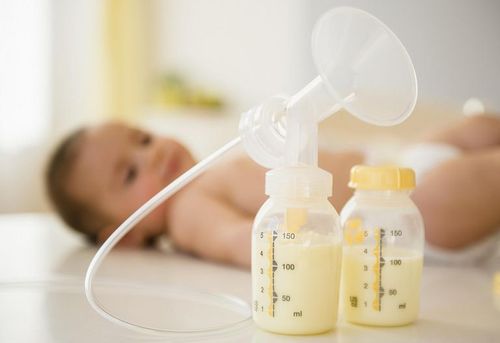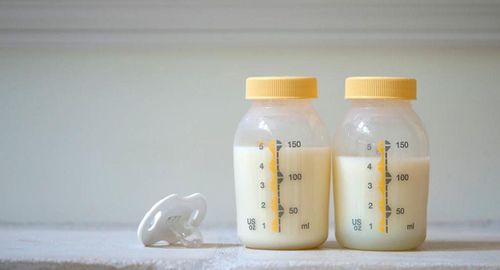This is an automatically translated article.
The article was professionally consulted by Specialist Doctor I Bui Thi Ha - Pediatrician - Neonatologist - Department of Pediatrics - Neonatology - Vinmec Ha Long International General Hospital. He has over 11 years of experience working in the field of Pediatrics - Neonatology and has strengths in the field of pediatric cardiopulmonary resuscitation, neonatology, access to diagnosis and treatment, neonatal diseases such as premature birth, neonatal diseases, and neonatal diseases. membranes, respiratory failure, neonatal sepsis.Breast milk is the best source of nutrition for babies, especially babies under 1 year old because breast milk contains all the necessary nutrients. When the mother has to go to work soon after giving birth, and cannot afford to feed the baby according to the meal, the best way is to express milk and leave it at home to feed the baby.
1. How to store expressed breast milk?
In case the mother who works away from home does not return to breastfeed according to the child's feeding, but the agency has a refrigerator, it should be expressed (when the milk is full) to store in the refrigerator and bring back to the child to eat.Especially, mothers who have a lot of milk in the first few months after giving birth, but the children do not drink all of it, they should also express milk to save when they go to work, which can be taken out to feed the children. This way, the mother will take advantage of the precious breast milk source without the mother's milk blockage.
Expressed milk can be stored in the refrigerator or freezer. Specifically: 72 hours in the refrigerator, 1 month in the freezer, 3 months in the freezer (although it can reduce the loss of antibodies in milk, it still has nutritional value). Once reheated for one serving, leftover milk must be discarded.
After expressing milk, the mother stores the milk in a plastic or glass bottle (sterile boiled) and then puts it in the freezer. Line up horizontally, the leftmost jar is the oldest, the rightmost jar is the newest. Make a note of each bottle the day it is squeezed so that the baby can use it from old to new.

Nên rã đông tự nhiên trước khi hâm sữa
=>> See more How to store breast milk safely
2. Instructions for warming breast milk properly
Absolutely do not boil breast milk on the stove because doing so will destroy the beneficial components in breast milk, especially antibodies and other micronutrients. The mother should warm the milk in the container by soaking the whole bottle in a cup of warm water so that the temperature in the breast milk bottle does not exceed 40 degrees Celsius.If the breast milk has been frozen, it can be thawed by putting the bottle in the freezer. Once the milk has thawed, shake well and be sure to test the temperature by putting a few drops on the back of the hand of the nurse to make sure before feeding. Only warm the amount of milk your baby needs during that feeding. If it is suspected that the milk has been sour or spoiled, it must be checked immediately, if it is true, the baby should not be breastfed.

Hâm sữa đến nhiệt độ 37 độ C là phù hợp
=>> Parents can refer to the doctor's article on how to deodorize frozen breast milk
3. Things to know about warming breast milk for babies
Some traditional views believe that if you heat the milk, it will lose nutrients, so feeding your baby thawed milk at room temperature is the safest. In fact, not all heating methods lose nutrients. Vitamins and antibodies in breast milk are often lost when exposed to extreme heat or due to force (shaking hands).
Currently, there are commonly used methods of warming breast milk such as soaking in boiling water, using a microwave oven, using a bottle warmer... It is important when warming breast milk that mothers need to control both temperature and time well. new time makes milk still retain the ratio of nutrients. Using a bottle warmer helps preserve nutrients in breast milk better. The ability to store vitamins of the machine is also higher than the microwave oven. Moreover, the mother can control the safe temperature in a certain period of time, the milk quality is not lost, and it is convenient and safe.

Dùng máy hâm sữa giúp bảo toàn dinh dưỡng sữa tốt nhất
Regarding the temperature of warmed milk, it should be exactly 37 degrees Celsius. The reason babies like to breastfeed directly is because the milk is always warm like the mother's body, bringing a sense of belonging. 37 degrees Celsius is the standard temperature, but mothers need to choose a method of warming milk that ensures the following criteria: temperature, time and nutrition.
Many mothers want to quickly defrost milk for their baby to drink, so use a microwave oven, soak in hot water. These methods often make hot milk old, have to wait for it to cool down to the ideal temperature before giving it to the baby to drink.
Microwave is the fastest, but it creates uneven hot and cold spots, which can cause the baby to burn while feeding. In addition, electromagnetic waves can destroy essential vitamins, causing a loss of nutrients in breast milk.
Hot water immersion preserves most of the nutrients, but it is difficult to adjust the correct temperature. Many mothers do not want their children to have to wait for a long time, so they often shake vigorously to quickly warm the milk, without knowing that strong impact can break and break the molecular structure in nutrients.
The milk warmer has a standard heat preservation mechanism, warms milk at 37 degrees Celsius with steam for 6-10 minutes. Nutrition is kept almost intact, especially the two substances lactose and protein.
For more nutritional knowledge and child care for each age, parents should regularly visit the website vimec.com and make an appointment with the leading doctors, pediatric and nutrition experts of the National General Hospital. Vinmec when needing advice on children's health.














